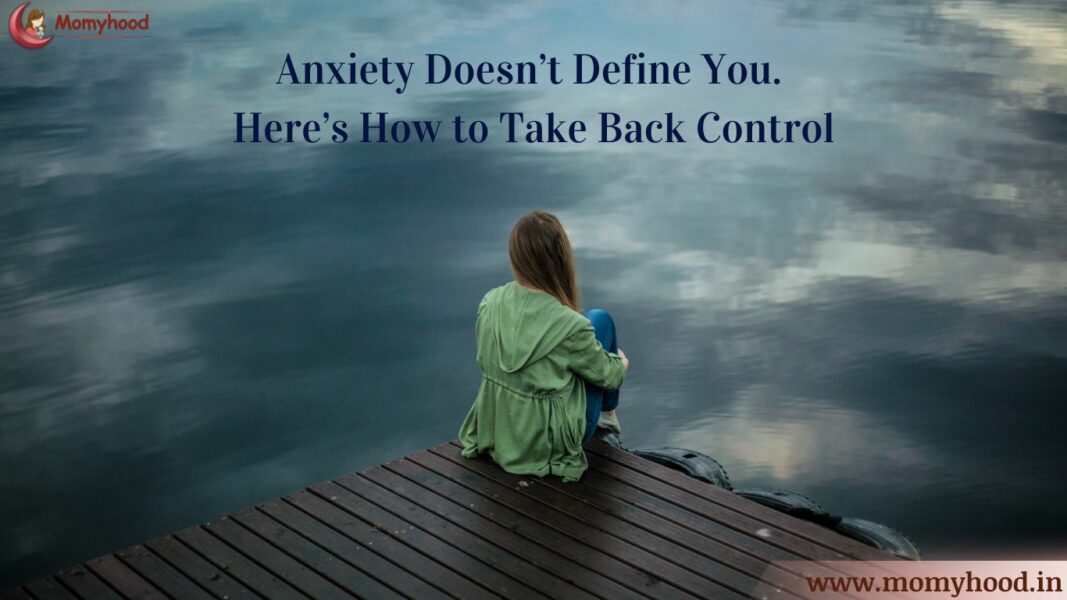Hey Mama,
I see you. I really do. You’re juggling a million things, running on fumes, and yet, you’re always questioning whether you’re doing enough. Believe me, I’ve been there. That constant rush of responsibilities, the never-ending to-do lists, and the overwhelming desire to be the perfect mom can make it feel like you’re drowning sometimes.
Not too long ago, I felt like I couldn’t catch my breath. My anxiety had taken over, and it seemed like every thought was a worst-case scenario:
❌ What if I mess up my child’s future?
❌ What if I never figure out how to balance it all?
❌ Why does it seem like every other mom has it all together?
My mind would race at night when I should’ve been resting. And even though I was exhausted, sleep felt like a distant dream. It wasn’t just about stress—it was constant fear, worry, and that nagging feeling that I was somehow failing.
📣 Loved what you read? Want to go deeper into conscious parenting? ✨ The Power of Manifestation in Parenting is now available — A soulful guide packed with real-life tools like affirmations, energy shifts, and sleep talk that I personally use with my son, Hitarth. 💛 Start your journey toward calmer, connected parenting today. 🎉 Launch Offer: Only ₹99 (limited-time price!) 📲 Instant download. No waiting. 👉 Grab your copy now!.
But you know what? I realized something important: Anxiety doesn’t have to define you, Mama. And it definitely doesn’t have to control you. Managing anxiety as a mom isn’t about eliminating stress completely; it’s about learning how to handle it in a way that protects your peace and well-being.
It wasn’t an overnight transformation, but little by little, I started using science-backed techniques and subconscious reprogramming to retrain my brain. Today, I want to share everything I’ve learned—so you can manage your anxiety, too, and finally find some peace.
What is Anxiety & Why Do Moms Experience It?
Anxiety isn’t just about being stressed or having a bad day. It’s that constant sense of unease, fear, or worry that lingers even when there’s no real danger. For us moms, the anxiety can be especially suffocating because it often hits at the worst times—when we’re already juggling a million other things.
Understanding the root cause of your anxiety is the first step toward managing anxiety effectively and reclaiming your emotional balance. Here are some things that can trigger anxiety in moms:
✔ Overwhelming responsibilities: Whether it’s balancing work, school runs, or home duties, it’s a lot.
✔ Sleep deprivation & hormonal imbalances: Being a mom is a 24/7 job, and often, sleep takes a backseat.
✔ Fear of making the wrong decisions for our kids: We want the best for our children, but it’s hard to feel confident when there’s so much at stake.
✔ Pressure to be the “perfect” mom: Social media doesn’t help when everyone seems to have it together, right?
✔ Financial worries: Managing a household’s finances can be a huge stressor, especially when unexpected expenses pop up.
✔ Lack of personal time: As much as we love our families, it’s hard to feel like ourselves when there’s no time left for self-care.
Did You Know? Many moms deal with something called high-functioning anxiety. On the outside, you may seem perfectly fine, but on the inside, your mind is racing. I know that feeling all too well.
The good news? You can reprogram your brain to feel calm and safe again. It’s totally possible, and I’m here to guide you through it.
Also read: Breaking Free from Anger: My Journey to Emotional Healing & Peace
5 Quick Ways for Managing Anxiety Instantly
When anxiety hits, it can be tough to calm your racing thoughts. If you ever feel like anxiety is taking over, remember that managing anxiety starts with small, intentional steps that bring you back to the present moment. So here are 5 techniques you can use to find immediate relief:
1. Question Your Thoughts (Are They Even True?)
Our minds tend to create worst-case scenarios—yet, most of the time, they’re not based on reality.
Next time you feel anxious, ask yourself:
➡ Is this a fact, or is it just my fear talking?
➡ What would I tell my best friend if she had this thought?
➡ What’s the best-case scenario here?
It’s all about reframing your thought patterns. For example, instead of saying, “I’m failing as a mom,” shift it to:
✅ “I love my kids, and that makes me a great mom.”
Changing the narrative in your mind can make a huge difference.
2. The 4-7-8 Breathing Technique
Breathing is your body’s natural reset button. It’s one of the fastest ways to calm your nerves. Managing anxiety with breathwork is scientifically proven to lower stress hormones, calm the nervous system, and create a sense of inner peace.
Try this simple yet powerful technique:
✔ Inhale for 4 seconds
✔ Hold for 7 seconds
✔ Exhale for 8 seconds
✔ Repeat 5 times
It tells your nervous system: “I am safe.” And that’s exactly what you need when anxiety takes over.
3. The 333 Rule for Grounding
When your mind spirals into “what if” thoughts, grounding techniques can help you come back to the present.
Here’s a simple one:
✔ Name 3 things you see
✔ Name 3 things you hear
✔ Name 3 things you can touch
This simple exercise brings you back to the present moment, instantly stopping those anxious thoughts from spiraling.
4. Move Your Body (Shake Off the Anxiety!)
Physical movement releases built-up stress and tension.
Try:
✔ 10 jumping jacks
✔ A 30-second dance break
✔ A quick walk around your living room
Even just a minute of movement can shift your energy and break the cycle of anxiety.
5. Use Aromatherapy (Scent Therapy!)
Essential oils have been used for centuries to calm the mind. Lavender, chamomile, and sandalwood are especially effective for soothing anxiety.
Here’s how to use them:
✔ Diffuse oils in your home
✔ Apply essential oils on your pulse points (like your wrists or neck)
✔ Light a scented candle in the evening as a signal to wind down
These simple, natural remedies can make a huge difference in your daily anxiety management.
5 Long-Term Strategies for Managing Anxiety for Good
While quick fixes are great for immediate relief, long-term strategies help retrain your mind and body to respond to stress in a healthier way. Building these habits will make managing anxiety easier and more natural over time.
1. Identify Your Anxiety Triggers
Anxiety doesn’t appear out of nowhere—it is usually triggered by something, even if it’s not always obvious. Identifying these triggers is the first step toward managing anxiety effectively.
Common Anxiety Triggers for Moms
✔ Caffeine & Sugar Overload – That extra cup of coffee or sweet treat might be spiking your anxiety without you realizing it.
✔ Sleep Deprivation – Lack of rest can make you more prone to anxious thoughts and emotional instability.
✔ Social Media Comparison – Seeing other moms “doing it all” can create unnecessary pressure.
✔ Unfinished Tasks – A cluttered home, unpaid bills, or a never-ending to-do list can overwhelm your mind.
✔ Past Trauma or Stress – Childhood experiences, difficult relationships, or postpartum challenges can unknowingly resurface.
How to Identify Your Triggers
📌 Keep an “Anxiety Journal” for one week. Each time you feel anxious, write down:
✅ What were you doing?
✅ Who were you with?
✅ What thoughts were running through your mind?
✅ What time of day was it?
Once you identify your most common triggers, you can work on minimizing or reframing them.
✔ If caffeine is a trigger, switch to herbal teas or decaf.
✔ If social media comparison stresses you out, unfollow accounts that make you feel less-than.
✔ If lack of sleep is a problem, create a relaxing nighttime routine with minimal screen time.
💡 Tip: Not all triggers can be eliminated, but you can change how you respond to them. Awareness is key.
2. Journaling: The Anxiety-Relief Hack
Journaling is like a mirror for your thoughts—it helps you process emotions, recognize patterns, and release worries that would otherwise stay trapped in your mind. Unlike manifestation (which focuses on creating a positive future), journaling helps you understand your current emotions and reframe them.
How Journaling Helps with Managing Anxiety
✔ Declutters the Mind – Writing down anxious thoughts makes them feel less overwhelming.
✔ Helps Identify Patterns – Over time, you’ll notice what situations trigger anxiety.
✔ Provides Emotional Release – Instead of bottling up emotions, you put them on paper.
✔ Encourages Self-Compassion – When you reflect on past journal entries, you see how far you’ve come.
Different Types of Journaling for Anxiety Relief
📖 Morning “Brain Dump” Journaling:
💡 Write everything on your mind the moment you wake up—fears, worries, tasks—without judgment. This declutters your mind and prevents anxiety from building up throughout the day.
📖 Gratitude Journaling:
💡 Write three things you’re grateful for every day. Gratitude shifts your focus from stress to abundance, reducing anxious thoughts.
📖 Anxiety Trigger Reflection Journaling:
💡 Each time you feel anxious, write:
✔ What triggered it?
✔ What emotions did I feel?
✔ How did I react?
✔ What can I do differently next time?
💡 Science Says: Regular journaling reduces anxiety symptoms by 40% when practiced consistently!
3. Reduce Caffeine & Sugar
Did you know that what you eat and drink can either increase or decrease anxiety?
Many moms rely on caffeine to get through their busy days, but too much can trigger anxiety symptoms like:
❌ Rapid heartbeat
❌ Restlessness & jitteriness
❌ Overthinking & racing thoughts
Why Caffeine & Sugar Can Make Anxiety Worse
☕ Caffeine stimulates the nervous system and increases cortisol (the stress hormone), making anxiety feel more intense.
🍬 Sugar causes energy crashes, which can lead to mood swings, irritability, and anxious feelings.
💦 Dehydration mimics anxiety symptoms, making you feel lightheaded and on edge.
How to Reduce Caffeine & Sugar Without Feeling Deprived
✔ Swap coffee for herbal teas like chamomile, peppermint, or lemon balm (all known for their calming effects).
✔ Reduce sugar gradually by replacing sweets with fruit or nuts.
✔ Increase water intake—dehydration can make anxiety worse!
✔ Try magnesium-rich foods like dark chocolate, almonds, and bananas (magnesium naturally calms the nervous system).
💡 Tip: If you can’t give up coffee, try drinking it after breakfast instead of first thing in the morning—this reduces its impact on cortisol levels.
4. Meditation: Train Your Brain to Be Calm
Meditation isn’t just for yogis—it’s one of the most powerful tools for managing anxiety long-term. Even just 5 minutes a day can rewire your brain and help you stay calm under pressure.
How Meditation Helps Manage Anxiety
🧘 Reduces overthinking – Meditation helps you observe your thoughts without getting lost in them.
🧘 Calms the nervous system – It lowers cortisol and activates the relaxation response.
🧘 Increases self-awareness – You learn to respond instead of react to stress.
🧘 Strengthens emotional resilience – Regular meditation trains your brain to stay calm even in difficult situations.
How to Get Started with Meditation (Even If You’ve Never Done It Before)
✔ Start Small: Just 2-5 minutes a day is enough to feel a difference.
✔ Use Guided Meditations: Try apps like Calm, Headspace, or Insight Timer for beginner-friendly sessions.
✔ Try Breathing Meditation: Focus on your breath—inhale deeply, exhale slowly. If your mind wanders, gently bring it back to your breath.
✔ Experiment with Walking Meditation: If sitting still is hard, try focusing on your steps, the sounds around you, and how your body moves.
Best Types of Meditation for Anxiety Relief
🧘♀️ Mindfulness Meditation – Focus on the present moment without judgment.
🧘♀️ Loving-Kindness Meditation – Send positive thoughts to yourself and others.
🧘♀️ Body Scan Meditation – Bring awareness to different parts of your body and relax them.
🧘♀️ Visualization Meditation – Picture yourself in a peaceful, happy place.
💡 Science Says: Just 8 weeks of regular meditation can rewire the brain, reducing anxiety and increasing emotional stability!
Manifestation: Reprogram Your Mind to Reduce Anxiety
Now, let’s talk about something even more powerful—manifestation.
While journaling helps you understand and process your emotions, manifestation is about actively shaping your future mindset. It helps you shift from anxious thoughts to an empowered belief system where you feel calm, in control, and aligned with your desires.
💡 Anxiety makes you believe bad things will happen. Manifestation helps you believe in the best-case scenario instead.
How Manifestation Helps with Managing Anxiety
✔ Rewires Negative Thought Patterns – If you always think “something will go wrong,” your brain keeps searching for danger. Manifestation shifts this to “Everything is working out for me.”
✔ Focuses on Abundance Instead of Lack – Anxiety comes from fear. Manifestation helps you expect positive outcomes instead.
✔ Programs the Subconscious for Peace – The more you affirm calmness, the more your mind accepts it as reality.
How to Use Manifestation for Anxiety Relief
🌟 1. Affirmations to Rewire Your Thoughts
The words you say become your reality. Start repeating:
✅ I am safe, calm, and in control.
✅ Everything is working out in my favor.
✅ I choose peace over worry.
Repeat these affirmations daily—especially when anxiety kicks in. The more you say them, the more your subconscious believes them.
🌟 2. Visualization: See Yourself at Peace
Take two minutes daily to imagine yourself calm, happy, and at ease.
✔ Close your eyes.
✔ Picture yourself handling a stressful situation with ease.
✔ Feel the peace in your body.
💡 The brain doesn’t know the difference between real and imagined experiences. Visualization helps retrain your nervous system to expect calmness instead of anxiety.
🌟 3. The “What If Everything Goes Right?” Exercise
Anxiety asks: What if everything goes wrong?
Instead, ask yourself: “What if everything turns out BETTER than I expect?”
📌 Example: Instead of thinking: “What if I mess up my child’s future?” → Reframe it as: “What if I’m exactly the parent my child needs?”
🌟 4. Gratitude as a Manifestation Tool
Instead of just journaling what you’re grateful for today, also write:
✨ I am so grateful that I now feel calm and confident every day!
✨ I love how peaceful my mornings feel now!
✨ I’m so thankful that I always attract ease and joy in my life!
Write these as if they are already happening. Your brain will start to believe it, and over time, anxiety will feel less dominant.
Related read: Self-care for anxiety
FAQs: Managing Anxiety
1. Can anxiety go away completely?
Yes! With consistent practice, mindset shifts, and support, anxiety can become much more manageable—and even fade over time.
2. What’s the best anxiety technique for busy moms?
Even just a couple of minutes of deep breathing or journaling can make a big difference.
3. Is anxiety a mental illness?
Occasional anxiety is completely normal. But if it interferes with your daily life, it could be an anxiety disorder, and there’s plenty of help available.
4. What is the best natural remedy for anxiety?
✔ Breathwork
✔ Aromatherapy
✔ Mindfulness & meditation
✔ Journaling
Final Thoughts: You’ve Got This, Mama!
Anxiety doesn’t define who you are. You are strong, capable, and worthy of peace. Every step you take, no matter how small, is a step toward managing your anxiety.
Managing anxiety isn’t just about calming your nervous system; it’s also about rewiring your subconscious mind. Manifestation, visualization, and affirmations are powerful ways to attract peace into your life—because what you focus on expands.
Start with one small technique today. Maybe it’s breathing or journaling, but take that first step. You’ve got this, Mama.
Which technique are you excited to try first? Comment below! I’d love to hear what’s helping you manage your anxiety. ⬇
Your comments and shares do more than just support our blog—they uplift the amazing moms who share their stories here. Please scroll down to the end of the page to leave your thoughts, and use the buttons just below this line to share. Your support makes a big difference!



